#if there is any personality trait that is consistent and unchanging with his growth throughout the years its his pettiness.
Explore tagged Tumblr posts
Text
[chapter 630+ spoilers]
its so funny to me that although ludger could have easily and efficiently wiped his enemies with the power of [the goddess who loves humans very much], instead, he chose to flex his power and completely obliterate them in the most petty way possible. he killed:
the lightning wizard of color with lightning
the fire wizard of color with fire
the entire holy army with holy power
the almost equivalent of the pope with the same god that he worships
you cant even call this massacre a poetic vengeance because he clearly didnt even see them as a worthy enemy but more of a swarm of annoying pests that need extermination.
ironically, ludger was created to become a vessal of a god, yet not only he rejected this divinity but also became the exact opposite of one — the manifestation of pettiness, a trait that is unmistakably very human.
#academy's undercover professor spoilers#academy's undercover professor#poetic vengeance? no. dramatic pettiness? yes.#if there is any personality trait that is consistent and unchanging with his growth throughout the years its his pettiness.#many of his other traits can also be traced back to his pettiness.#also the opposite of gods isnt demons cuz the existence of demons is entirely lumensis' propaganda#gods dont care about the crimes and atrocities humans commit onto each other because they dont care abt such trivial things#but ludger does because he is a human ''living in this world''#a very petty human at that#and his pettiness is direct proportion to his care for humanity#or should i say... it is how his care for humanity manifests#auposting
93 notes
·
View notes
Text
LoV Colour Analysis Part I: Shigaraki Tomura.
As this analysis would be quite too long to read in one go, I decided to split it into three parts, each covering one of the Three Main Villains of BNHA (Shigaraki Tomura, Himiko Toga and Dabi).
All three do denote a precise and powerful colour scheme, but on today’s episode I am going to focus on the Leader of the League of Villains aka Shigaraki Tomura or Shimura Tenko.
Shigaraki’s colour pattern variates from Red (shoes and eyes), Black (his usual outfits, his hair when younger) to Light Blue, Grey and White (colour of his hair, skin and hands).
The interesting fact is how Shimura’s colour evolve with his persona and Quirk. The third paragraph is dedicated to the colour Yellow, which is not part of the palette associated with Tenko, but I included it because it adds to the detailing of Shigaraki’s character.
(Spoilers ahead! & tw/: mentions of canon-compliant violence; death)
I.) From Black to Light Blue to White
During his growth, evolution as a villain and person, not considering the one spurred from his Quirk, Tenko’s hair undergo a quite big development. While the colour of his clothes stays more or less stable (being black throughout the entire series), what differentiates his eras is the colour of his hair. In his childhood, before manifesting his Quirk, Tomura’s hair was dark (strikingly similar to the one both Touya and Izuku sported). This changed to light blue/grey in his years until last arc, where after being himself an experiment under the hands of Doctor Death (Kyudai Garaki is a very creepy man) to inherit the original AfO’s Quirk, his hair becomes snow white (as a result of the transformation, I would believe - but it might as well mean another thing which I will talk about later).
Beginning with maybe the easiest association: the colour black.
A little note of the fear association: in this case, I would like to interpret it as Shigaraki being aware of his decaying Quirk and freak people out because of that, and because of his external looks, which do look like the one of a decaying child.
Power refers definitely to both his position and his Quirk, in this case - which make him stand out even more. However, the strength in this case, in my opinion, is more a smoke screen: black is also worn as a protection from external damage, as in stress and emotional backlash. This creates a barrier between the subject and the world, protecting internal emotions, and hiding its vulnerabilities, insecurities and lack of self confidence. The emotional trauma, the ‘hands shield’ Shigaraki derived, in a way, from his trauma and from being confronted with something, has shaken him to the core since childhood, and in this case the clothes serve to protect him from himself and his ‘actions’. In this aspect, him wearing black as a child might also stand for him trying to shield himself away from his parent’s judgement and stare, while protecting his will to want to be a hero, despite their negative reaction to any hint of that. These meaning are, in conclusion a full circle: one calls for the other, especially in Shigaraki’s case.
Black is also associated with mystery, evil and aggression. Shigaraki is written as an enigmatic villain, cold-hearted, devoid of any humanity and the will to full front destroy everything in its path. And while the meaning perfectly fit to how Shigaraki should be, I do believe that this is a very superficial and banal description of such a complex character.
One thing which I found particularly interesting about this colour and its relation to Shigaraki, it’s the rocky tie that appears between black and its meaning as in rebellion. This aspect might refer to two different conditions: it might suppose a certain degree of refusal and hate for authority (The society at large), and at the same time the rebellion from his own family/persona/mentor, which could entail a fundamental foreshadow for Tenko’s destiny.
The color black affects the mind and body by producing feelings of emptiness, gloom, or sadness.
I think here again, this might just an extermination of the feeling that have been torturing Shigaraki from the inside since he was a child, and that he himself has not acknowledged, which also stands to explain how he tries to feel that void or to ‘eliminate the scratch’ that has been tormenting him, and that knows no peace.

Furthermore, In Japanese culture, the colour black mainly denotes non-being (apart from mourning) and evil-heartedness in a person. This meaning is consistent with the personality described to us by Horikoshi: Shigaraki Tomura ceases to be a person at one point, when his consciousness gets subdued by AfO for a while. It is important to note here, how White (on the other side of the spectrum) is also the colour of death and mourning.
Not entirely worth mentioning, is that black is the stereotypical colour worn by villains and bad guys in different fictional environments.
(Light) Blue/Grey.
Just a reminder: neither grey nor blue are explicit colour in Tenko’s palette as a character, but I think they are still important and since greyish blue (the precise colour oh his hair) has not its own meaning, I took the freedom to actually associate the two separate colour in association to describe this period of transition between black and white.
The phase in which Tomura has Greyish-Blue hair is the longest one (in terms of years), but also the phase of passage (which consequently is the phase he is exploring, and is in the ‘grey zone’, where things are just getting defined and there are no absolutes). Grey, in this sense, sports both characteristics from White and Black (depending on the shade used), and even if not explicitly used for Tenko, it still represents a landmine in his development.
The colour grey is an ‘unemotional’ colour. It is detached, neutral, impartial and indecisive - all traits that can be reconnected at Shigaraki. Indeed, it is after his encounter with Izuku at the mall where he recognises why exactly (or so he thinks) he rages and wants to bring destruction to the world as known. This indicates how he has been striving for a real purpose, like the one Stain has, in order to actually understand what he is doing and evolve from the child the Heroes define him as, to a Villain with the capital V. He does relate to reality in partial ways, while he tries to define his identity as something that has died inside of him, Shimura Tenko, and at the same time the part that has lived on through the memories he removed and the hands which accompany him. He does not know which part is stronger, and trying to figure it out he tries and fails, only to try again. To confirm the shaping of Shigaraki, indeed grey is a conforming colour and most of all it struggles with identity, which is arguably the most prominent trait Shigaraki presents during the first arcs of the story.
On the other hand, Blue symbolises coolness, passivity, fidelity. Somehow it reverberates the meaning of grey, while at the same time enhancing its other effects (it being emotionless and calm, undecided but also flowing). Blue is also indicator of depth, wisdom, confidence, and intelligence (among others). This also confirms the precedent meanings (of especially white) and it adds another dimension to Tenko’s character. It is clear how he feels deeply, and is still very clever in its own way. Still, this development and phase serves for him to obtain the other characteristics proposed by blue, especially wisdom and confidence (refer to Black where I said how sometimes the clothes are a screen to hide his true feelings).
Blue is a colour that’s constant and unchanging, which contrasts with grey and brings forwconstant struggle in Tenko. Blue is also nostalgic. Curious is how blue lives in the past, relating everything in the present and the future to experiences in the past. I think that this is what blue is about with Tenko: he struggles to look forward, to forgive and let go because he never forgot his dad, his grandma or even society for when they had brought upon him as an innocent child. His bringing up has been focused, after all, on his developing his constant feeling of sadness, rage and gloom and the necessary power to express them in confident ways, which could bring destruction forward. Tenko is a puppet in AfO’s hands since he has ‘saved’ him, so I think this is why the sentence in which Shigaraki tries to break free from AfO’s will is a break point for the story, and for Shigaraki as well.
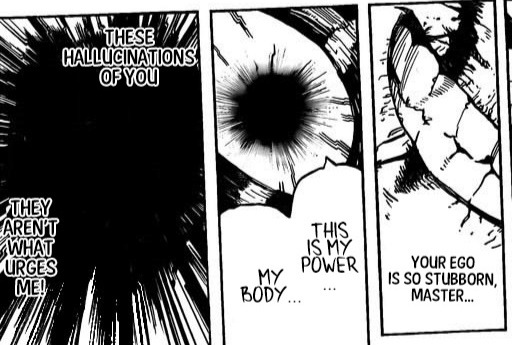
Blue is also known for being deceitful and spiteful, depressed and sad, passive, self-righteous, emotionally unstable, weak, unforgiving. It can also indicate manipulation, unfaithfulness and being untrustworthy.
Indeed, it is after that Izuku sees Tenko being kneeled over by AfO and his presence that he understands that Shigaraki too, is human and that maybe the reasons for his rage and absolute hate for everything he comes across have deep roots, which is why even if he cannot forgive him for all the pain he has brought, he wants to save him.

Finally, the paler the blue the more freedom we feel - which brings me to my theory on what, throughout the years Tenko’s hair have been ‘decaying’ and bleaching out. I think that as a child, Tenko is caged and tries to break free of his cage, of his ‘itch’ but he cannot because he does not realise what it is, and there is no freedom for him to actually understand. The first time he uses his Quirk, he feels finally satisfied for the first time. He tasted freedom for the first time, and now he wants to do it again and again. Growing up, however his ideals become blurry and he does not understand what he actually wants. He does know that the hands on his body represent what he has lost and what is actually still there with him, giving him strength and will, but at the same time he does not know what is beyond there. Which is why, after he goes through the transformation by Garaki, his hair becomes white: he gets rid of the insecurities, of the shackles that have stopped him from actually achieving his goal, or rather to pursue it freely. His ultimate goal, after all, is to get rid of his ‘itch’, which, in its own way, it’s his language to say that Shimura Tenko wants freedom.
As a note, Blue is also the colour of the Throat chakra. It is located in the throat, but it is linked to the throat, neck, hands, and arms. This Chakra is linked to speech.
Final remark on blue: this colour is one of the most important lucky colors in Japan ( together with yellow, white, purple, green and, red) - and all the colour associated with Tomura, except for black, is indeed considered lucky.
White
White, is an inherently positive colour, is usually associated with purity, innocence, light, goodness, beginnings, possibility and perfection. However it is also described an dperceived as cold, impersonal and bland. Shigaraki after his ‘transformation’ is the perfect soldier: he is very powerful, to a fault, and represents a new chapter in not only his own life but as well in the one which has been conducted by AfO, as he sees him as his vessel. The fact is that the beginning of a new Shigaraki which is flawless, in appearance, is a very well constructed lie. While he should represent perfection, first of all his transformation has not been entirely completed and furthermore, while it does represent a clean slate in his check, is also the possibility, reality coming through for AfO to take advantage of the body new, which Tomura must preserve. As the new Shigaraki however, has his ideals very present and wants to fight for them, to protect his feelings and his ideas, it is anyway a struggle for both him and AfO to juggle through everything going on Tenko’s mind, and emerge victorious. This is also the most interesting aspect of this colour: the goodness and inherent purity which comes from this colour implies a purification process in Shigaraki’s character, who instead gets fixed even more on him not wanting to forgive society and insisting on going on his rampage, because at the same time he cannot let go of these feelings, because now they are the only thing which make him go forward.
White is usually used in contrast to black, and represents the dichotomy of good and bad.
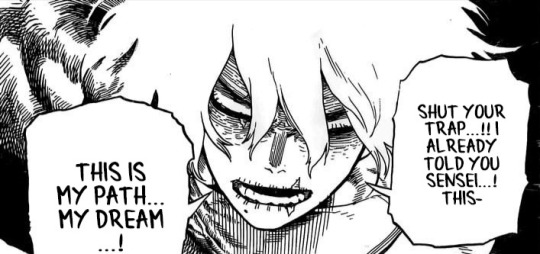

The psychological meaning of white is wholeness and completion. This also refers to the meaning and falls into the category of ‘perfection’: it is a new beginning, but at the same time it represents the closure of a cycle and the beginning of a new one: a perfect one, which represents closure (‘The Circle’). Tomura is supposed to be the new complete weapon at AfO’s will, but as I states before this is a fought point (between the two of them).
White, in cultures that believe in reincarnation is held in high regard. Indeed, they sustain how white is a sign of rebirth.
Technically, Shigaraki has been reborn. What I mean is that he has transformed himself into not a new person, but in a better version of himself, he upgraded - and now of course going back is not an option. He has been held in a womb, breeding his new potential and now he became an individual whose strength far surpasses normal, his quirk control is absolutely insane and as well his memories, ideas and feelings are heightened. The theme of rebirth, which I think fits both Shigaraki and Dabi, is used a few times in BNHA, but as for Shigaraki it is very literal and very clear (after all he has been asleep for a time, just to wake up and fight an entire war against the Heroes). It is clear however, how his personality has been rebirth too: while he was not insecure, but more hesitant, now he is sure of his objective and he thrives on achieving it. What distinguishes therefore the old Shigaraki from this new one is the knowledge of being powerful and therefore being able to accomplish what we wants.
Finally, white inherently denotes death and mourning too in the Japanese culture, as well as black. Here, we are mourning the old Shigaraki, and the loss of the traits that instead made him a little bit more human, and a little less like God himself.

II.) From Red Eyes to Red Shoes (in association with both Izuku and Katsuki)
I already talked about the colour red in regard to Izuku here, but if we take the same meaning and apply it to Tomura instead, we get a different picture. It is no mystery how Izuku and Tenko are foils for each other, and that they resemble each other in different ways (starting from them sporting red shoes, to their characters, being ‘accepted’ and trained by a mentor, and so on).
Red is the colour of extremes. It appears clear how Izuku and Tenko represent the opposite extremes: where Izuku is enamoured of heroes and idolised them to an unhealthy point, even though he comes from a background where he has been discriminated by that same society because he was different, Tenko is disillusioned with the society they live in. He wants to destroy to the ground, because he cannot find it in himself to forgive anyone who could and did not extend him a hand when he needed it. At the same time, both Izuku and Tenko believe that to a certain extent what they had done has been ‘deserved’, and are not entirely focused on their own well being.
Red is also an attention-bringer. As I already noticed for Izuku, it is very curious how both wear red shoes, as a way to try and separate themselves from the rest, trying to escape the opinions of other which have labelled them in a way, and of course at the same time trying to take control and wanting to be the best in their own ways (hero or villain, that is).
Red is also the colour of blood, of rage, anger as well as desire, leadership and strength. I want to make a point which I do not know whether is important or not, however, a fact that struck me hard is how Shigaraki’s irises are very very small, and it somehow seems that he tries to compensate the little quantity of red of Shigaraki with wearing red shoes. This might be an indicator how Shigaraki strives to achieve these qualities, but at the same time he needs to put a lot of effort in it, and furthermore it somehow feels different from when we compare it to Izuku: even if both are charismatic leaders, Shigaraki is very dispassionate about it, while Izuku frequently denies how his influence might be fundamental when it comes to other people (Katsuki, All Might, 1A). However, Shigaraki does reflect in his personality, the venous desire to be angry, aggressive and destructive as it what his power entails, and after all what has been taught to him. I noticed as well a post (which unfortunately I cannot find) where it says that Shigaraki has a very high tolerance pain (again, the parallels with Izuku are insane), which also reconnects somehow to the colour red as we saw how Shigaraki himself even if tired (LoV vs Machia/LF) or absolutely bloody and at the brink of death is instead held up by his will to destroy (Shigaraki vs Heroes).
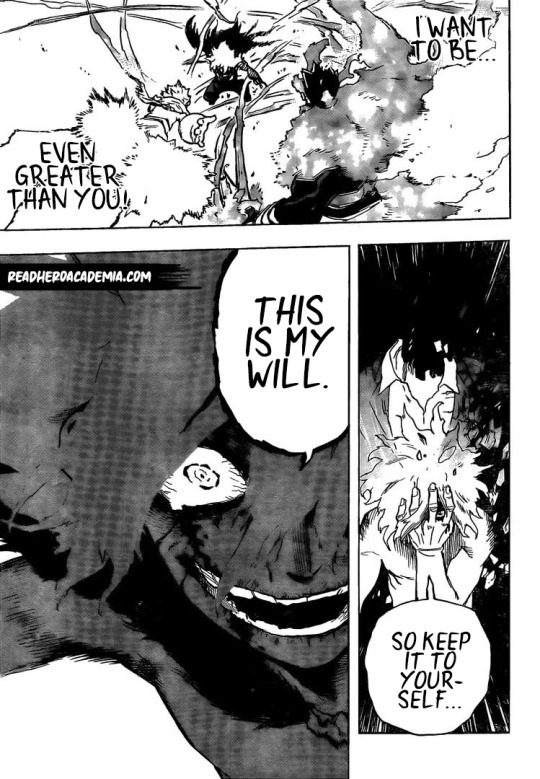
It relates to danger, power, determination and action. Well, Shigaraki and danger go to hand in hand as well as determination and action. After all, Shigaraki’s Modus Operandi is Trial and Error, which means he is not afraid to be wrong and to try things out, even if he is stubborn and ways things to go his way, every time (when that rarely happens in general).
Red is indeed determined, powerful, impulsive and aggressive. It is also tied to self-preservation. Although true for the most part, the self-preservation is still a massive blank point.
He is bloody, and even AfO is telling him to rest and preserve his energies (even if here, my counter argument would be that it would be easier for him to overtake Shigaraki’s body if he is weaker, so I do not know how reliable this is).

The color red in Japanese culture denotes strength, passion, self sacrifice and blood. It Also stands for good luck and happiness. Which is still very amusing to me, as Shigaraki feels like the farthest character away from achieving happiness, and his passions and strives are all useless unless he gets rid of his master puppeteer. However, Shigaraki embodies the self-sacrificing spirit. Even if it might sound strange, and he is not very willing to be himself in the front lines (at least not always), he does approach ReDestro himself and takes him on, while leaving the League to deal with the rest.
III.) Yellow
Surprise, surprise! Yellow, in the Japanese culture stands for Courage, while usually the Western culture associates it with Cowardice. It is a funny thing that it also stands for betrayal, sickness, egoism and madness on the negative side, however it is rather a holy colour, usually associated with deities on the other side.
Since I am not going to include yellow in the association paragraph, it is not a case that black reacts badly to yellow, and forms a very unpleasant colour, which means that the circumstances which follow either do not mix well together. However, it is also true how the most resonant contrast between yellow and another colour is given by black.
Plus yellow is the colour of the Solar Plexus Chakra and it is the symbol of vitality and will. All these elements, however present in a very limited amount in regard to Tenko, are telling of the aspect of authority (reconfirmed and amplified by black) and somehow, the lack of bright colours of Tenko makes the little yellow details resonating of a sad picture, as it embodies more the negative sides (egoism, sickness - and in part sickness).
Colours in Association.
Black used in contrast–particularly with white or yellow–does create energy (especially the contrast on shapes and just power that the image of waken up Shigaraki creates in the last arc is enough to send this message). It is as well true that black when used in opposition with white, symbolises the eternal struggle between day and night, good and evil, and right and wrong - a thing that for Shigaraki is somehow a metaphor and a literal representation of himself as a character. A perfect example would be the struggle he has with AfO for his body, where he struggles between his internal feelings and dreams and instead the evil will imposed by him by AfO, as well as in terms of consciousness where him being present and conscious is the day, while being subdued to AfO’s will in the Night.

Black usually represent the end, but the end always implies a new beginning. So when the light appears, and black transcends to white, it instead the colour of new beginnings. I already talked about how rebirth theme and the new beginning on new ideals and dreams is represented for Tenko by the colour white, however it is interesting also to note how his change in personality brings him from his childhood dream to being thankful to AfO who raised to him, but wanting to be even greater than AfO himself,- metaphor for Tomura’s life as being free from shackles of reality.
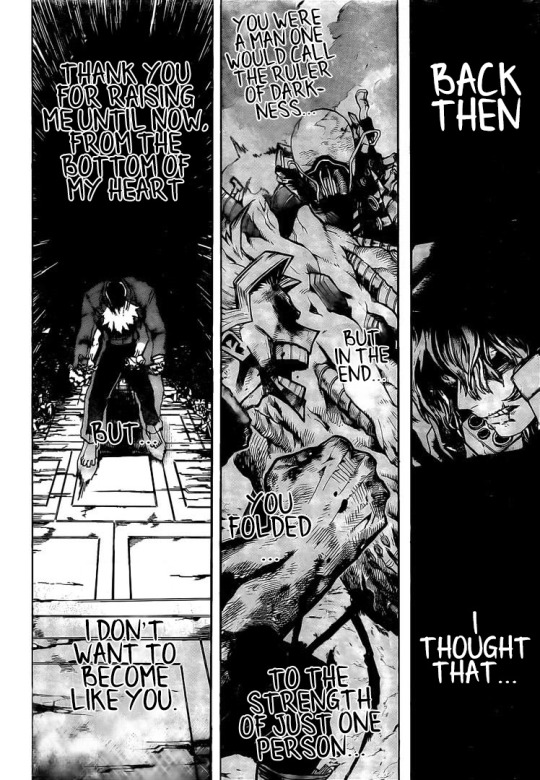
Bluish-Grey is also defined as ‘livid’, an adjective used to describe anger or decoloration of the skin (caused by bruising). This colour gives a sense of detachment - which also goes to review the colour grey and blue, in them being interpreted together as an entity, and how Tomura feels a detachment from his own memories, and past life, as well as his future (When Did We Ever Need A Future?) and instead seek meaning in everything that surrounds him.
Red and white are prominent traditional colours in Japan. Both colours are used in decorations at events which represent happiness and joy.
On a non serious note, Shigaraki’s date of birth is 4th of April, and casually the colours associated with April are Burgundy (deep red) and White (according to the Japanese etiquette).
And finally last remark for this post: it is very funny how Shigaraki’s palette is somehow almost the same as Bakugou’s (with the exception of green - which I would like to interpret as if Bakugou did not have Midoriya as his side, he could have ended in a far worse position, with no hope and no one to compare to).
Thank you for reading.
#mha#bnha#bnha meta#mha meta#mha analysis#bnha analysis#bnha color analysis#bnha theory#mha theory#mha color analysis#boku no hero academia#my hero academia#my hero academy#shigaraki tomura#shimura tenko#lov#league of villains#bnha spoilers#bnha manga#bnha manga spoilers#mha spoilers#mha manga#mha manga spoilers#dabi#Dabi is touya#todoroki touya#izuku midoriya#deku#bakugou katsuki#kacchan
77 notes
·
View notes
Text
Like some kind of “Man-Child”
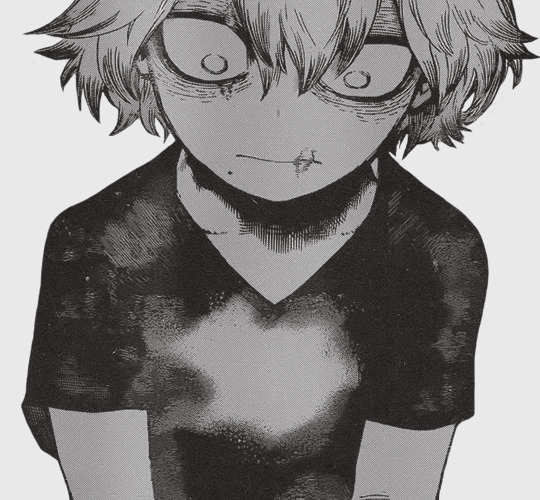
Shigaraki is constantly compared to a child by the other characters around him. Whether it’s the staff at UA calling him a manchild, Ujiko saying he’s a twenty year old brat who has accomplished nothing with his life, or Spinner saying he chases his dreams like a child, Shigaraki’s immaturity and underdeveloped psyche is something constantly commented upon others.
There are two questions to ask now. One, why did Shigaraki turn out this way, and two what does it mean for his character and future growth?
1. An Immature Manchild, A Worthless Twenty-Something, The Trash of Society.
Shigaraki is constantly described by others as acting like a child. In most cases it’s used to insult and demean him, and also to point out his lack of any real tangible goal.




However, Shigaraki’s childish tendencies, his egocentrism, his lack of ability to see the consequences for his actions, and his emotional instability are not a reflection of whether he is a good or bad person, it’s a reflection of his upbringing. This is an important point I want to make before we continu, the hero system uses all of the signs that Shigaraki shows up legitimate mental illness to dehumanize him and make him out to be a “dangerous psycho” rather than to show him any real sympathy.

All Might’s analyses him at length and comes to the conclusion not that this is an unstable person who shows clear signs of mental illness, but rather that the signs of mental illness he shows makes him a bad person. All of these traits that Shigaraki shows are used constantly by his enemies, heroes and villains alike to unperson him.

Once again, Shigaraki acting like a child is not a reflection of whether or not he’s a good or bad person. It’s a product of trauma and his upbringing. Heroes seem to be under the impression that a good person would simply not suffer or react negatively to any trauma. Shigaraki doesn’t grow up not because he doesn’t want to grow up and wants to remain an immature manchild forever, it’s because he was raised deliberately.
Developmental psychology is a scientific approach which aims to explain growth, change and consistency though the lifespan. ... Developmental psychologists study a wide range of theoretical areas, such as biological, social, emotion, and cognitive processes.
Shigaraki was raised in an environment where he could not healthily develop into an adult.
A child’s behaviour is an outward manifestation of inner stability and security. It is a lens through which the family physician can observe the development of the child throughout his or her life. All types of abuse are damaging to children—physically, emotionally, and psychologically—and can cause long-term difficulties with behaviour and mental health development.
Seeing the world from other people’s points of view. Thinking about the consequences of your actions. Processing your emotions and stress in healthy ways. These are all things children learn in the process of growing into adults. However, it’s a learned behavior not a natural one. The idea that people, children, are either born good or bad and will develop based on some internal qualities of goodness or badness is patently false. Children who receive no adult supervision growing up just turn feral and have no ego at all. The ego, or rather identity is something both heavily influenced by the interactions with the adults that raise them and interactions with members of the same peer group.
Shigaraki, raised in a basement with entirely selective and controlled interactions with others that were always underneath AFO’s direct supervision and his thumb, who probably did not even get that much freedom until the UA attack is just barely one step above a feral child who has no adult supervision at all.
These three behaviors:
Lack of Empathy.
Cannot View the Consequences of his Actions
Cannot handle emotions, setbacks and stress
They’re all explainable by specific manipulations that AFO introduced to him as a child. “Shigaraki feels no guilt for what he does” said by almost every hero who interacts with him, but this is completely incorrect. The truth is Shigaraki is constantly made to feel guilty.
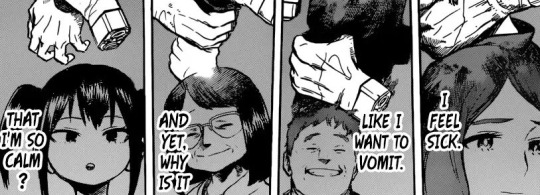

He hates himself, and constantly holds back his quirk because he still feels guilt for what happened to his family due to the accidental activation of his quirk.

He accepts the entirety of the blame for what happened for his family, and therefore views himself as a monster. This is what Shigaraki unconsciously believes and accepts, that he deserves to constantly be punished and tormented without relief for what he did for his family and that he can’t be saved.

These are not the actions of a person who feels no guilt. However, at the same time Shigaraki is seeking some relief from his suffering, he wants to be saved even though he believes he doesn’t deserve it. Therefore, AFO manipulates him into believing he doesn’t have to feel guilty for destroying the people he wants to destroy. This is literally the exact tactic that Chisaki used on Eri.

Tenko is constantly made to feel guilty for what he did to his family, and because of that he’s dependent on what AFO told him would make him feel better. Just like Chisaki convincing Eri that it was her fault that people who tried to save her died made her return to Chisaki.
Shigaraki doesn’t show any emotional maturity because he can’t. Being surrounded by your peers, being in a healthy environment, being taught lessons by the adults around you these are all things you learn growing up. We are shown constant signs that Shigaraki’s childhood was constantly barren. He was raised in a room that was entirely blank.

AFO controlled everything about his life. He didn’t even give him toys or books until he started murdering people, and we see that same room several years later almost completely unchanged from the way it was when he was a kid.



Shigaraki’s entire world was that one room. It’s even remarked that he wasn’t allowed to attend any kind of school.

Shigaraki was raised to have his entire world revolve around AFO’s desires for him. Shigaraki even acknowledges that he doesn’t even really want to accomplish AFO’s dream and knows it won’t satisfy him. It’s something that’s forced down his throat, but also what Shigaraki views as his only path forward. Shigaraki as a person doesn’t exist outside of AFO’s goals for him because he wasn’t raised or nurtured to be a person just a thing that wants destruction.


And, the reason Shigaraki continues to follow down the path set by him by All for One is a rather childish one too. This is once again where Shigaraki’s foiling with Chisaki is illustrative of his character.

This is how Shigaraki reacts when forcibly separated from AFO. Crying and begging like a child ripped away from their parent, completely helpless without him. AFO doesn’t act like a parent at all, but for Shigaraki he’s the closest possible thing. Shigaraki still believes that he owes AFO for saving him all those years back.

Shigaraki and Chisaki are the core of their beings are propelled by this idea that they need to repay their father figures for taking them in. They have this childish desire to make their father figures happy and please them, that’s just as true to their nature as their destructive impulses. So, they act like they were shaped to be. Chisaki acts like the perfect Yakuza member, and Shigaraki as the perfect symbol of destruction. They are both desperately trying to be what their parents want them to be.
Shigaraki can’t handle any setbacks or stress, because he is constantly stressed. He was raised to feel nauseatingly sick of himself all of the time.

Eri can’t act like a normal child because even after removed from Chisaki’s influence, the emotoinal wounds Chisaki left on her don’t magically go away. It’s not about being a good or bad child, it’s about being trapped in a certain unhealthy way of thinking.
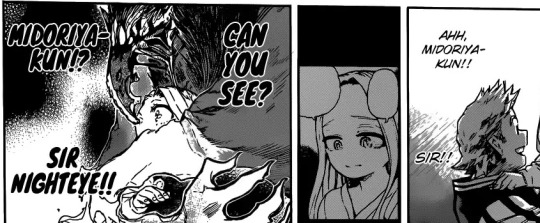
Shigaraki’s not entitled and emotionally immature. He’s emotionally stunted, and deliberately raised that way. If you could say he was raised at all. His captor had no interest in him as a person. He exists to be a pet revenge project against All Might, to turn Shimura Nana’s descendant into an unstable little bomb that explodes and takes out All Might with him.

The person who raised him constantly threw him into danger with no regard for his well being. He expected Stain to try to kill Tomura when they met and stopped Kurogiri for interfereing for his safety. He expected All Might to beat the shit out of him and for the UA attack to fail. This goes back all the way to the beginning.

He exposed Shigaraki to dangerous people who would beat him up, insult him, and belittle him. People that deliberately reminded Shigaraki of his abuser.

So he would be constantly made to feel unsafe and unstable. Shigaraki has no emotional stability because he was constantly raised in an unstable environment, it’s not hard to remain sane in that environment, it’s downright impossible.
2. Children can Grow Up

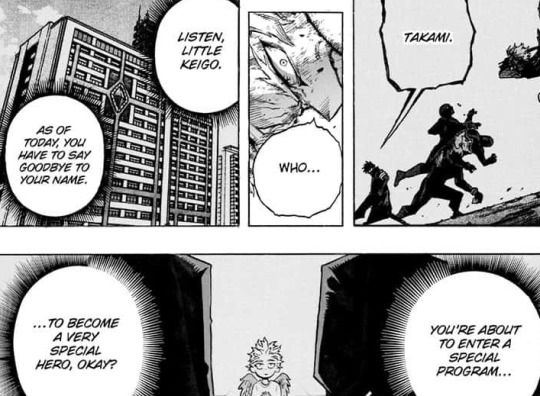

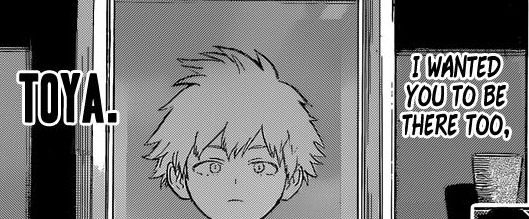
This is a theme we’ve seen repeat itself three times. A child is murdered and has their name taken away by their paternal abusers, and they make it into adulthood (despite symbolically dying as a child) with entirely different names and identities. Takami Keigo grows up into Hawks, Touya grows up into Dabi, Shimura becomes Shigaraki. However, all three of them as adults are malformed and still clinging onto the hurt feelings that they held as a child. Shigaraki and Dabi literally both look like corpses, and Hawks has literally no personality or name outside of being a hero.
It’s not a reflection of who they are as people, it’s a reflection that they were not raised to be people. However, Shigaraki is constantly remarked on as a child capable of growing up.
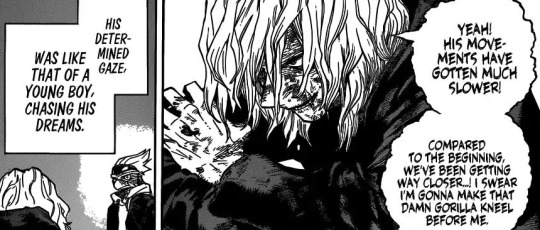
Spinner, Shigaraki’s friend sees the good side of his childishness. He is someone who late in life, is still learning and developing empathy. We see him change over the course of the story. Shigaraki who claims that he doesn’t care about anything besides destruction, also specifically states that he won’t destroy his companions hopes and dreams.
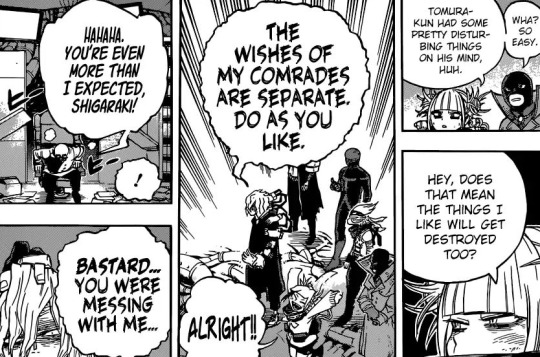
Shigaraki who is presented as a person who is entirely devoid of empathy, is shown being able to deal with somebody like Twice perfectly. Not only does he listen to Twice’s demands that they rescue Giran.
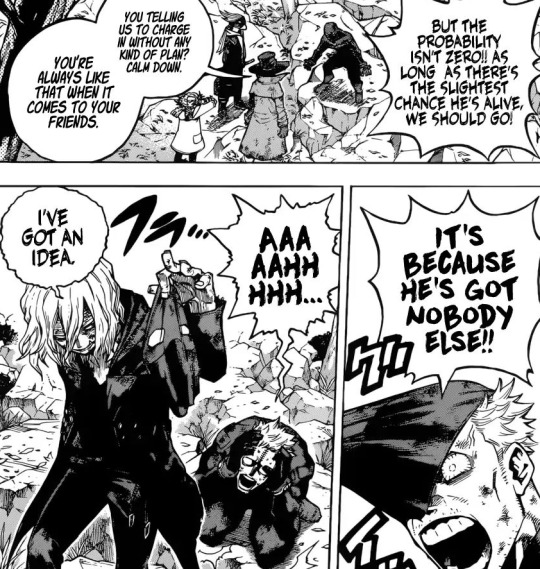
He also knows how to make Twice listen, and then carefully places his mask back on again to calm him down afterwards. He deals with him like a person and is accomodating of his quirks.

Shigaraki makes it deliberately a point that he’s not okay with someone else playing around with Twice’s feelings.

He also tells Twice to make saving Giran and protecting him a priority when he plans on finishing Rikiya himself.

All of this consideration for the feelings of an individual. Shigaraki’s empathy has grown and developed to the point where he can imagine the feelings of other people outside himself. Now compare this to the way Hawks deals with Twice. Shigaraki finds trampling all over the feelings of Twice as unforgivable, whereas Hawks brags to Twice’s face how easy it was to deceive him. He belittles him and rubs salt in the wound.

Hawks can only accept Twice as a good person. It’s Shigaraki who gives a home to those who have no other home, the outcasts, the bad people that heroes would never save.

Shigaraki who understood how important Twice’s feelings for his friends are, built his entire plan against the MLA around saving Giran, and Twice’s own desires to want to help his friend Giran and pay him back for giving him a place to belong. Hawks literally goes out of his way to single out Twice as the only one he can save and not extend the same helping hand to his friends. Shigaraki recognizes Twice’s feelings for his friends, Hawks goes out of his way to trample on the friends that Twice finds so precious.
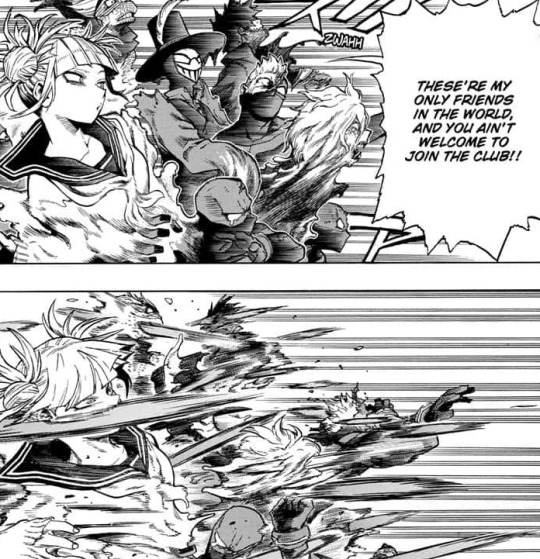
Hawks wants to save Twice but doesn’t understand him as a person. Shigaraki has created a place where people like Spinner, Toga, Compress, Twice, Dabi are all accepted and valued as people. Shigaraki’s childishness is both a good and bad thing. It shows that even after all of this trauma, the core of who Shigaraki is has not changed.

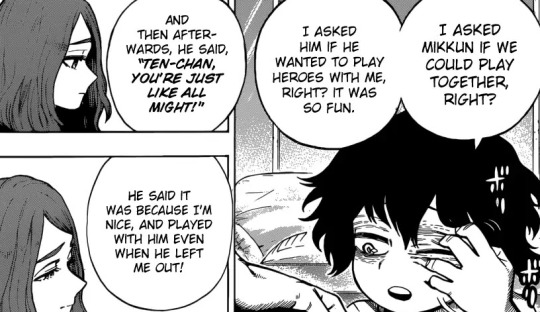
He is still the kid who deliberately plays with the kids on the playground who get left out. Who states that he specifically wants to be a hero because there were kids who were left out of being played. And who wanted to be a hero even when he knew his father would severely disapprove of it and kept that dream in his heart.
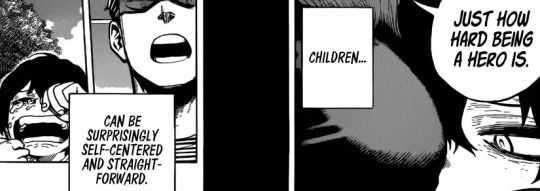
Shigaraki is still Shimura Tenko. He’s not the child who wanted to be a hero, or the child who wanted to destroy to make the pain go away, he’s both at the same time and that’s where his complexity comes from. Shigaraki like anybody else is capable of good and bad, but what’s especially important about his arc is that we’ve been shown that when removed from underneath the thumb of his abusers, and surroudned by his found family in the league Shigaraki gets better and is able to begin seeing the emotions and feelings of other people outside of him, and becomes a more empathic person. He is a child yes, but also a child capable of growing up.
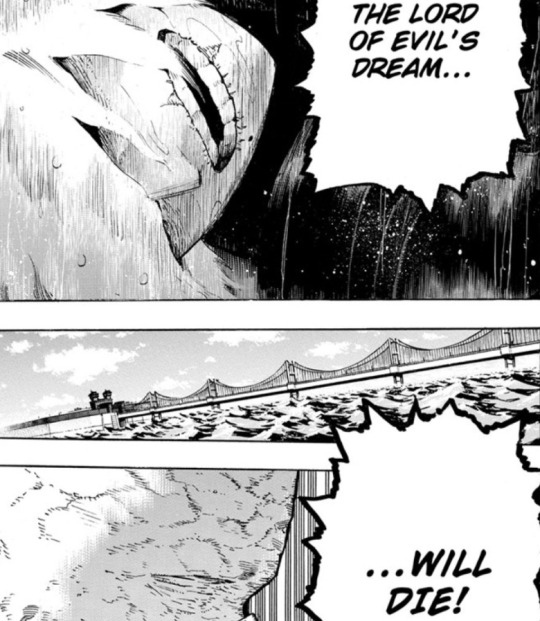
It’s also important to remember his arc. When Shigaraki is fighting for the league he always succeeds (against the Yakuza, against MLA). He only ever fails, and relapses (such as his current failure in the hero war arc raid) when he believes that he has to follow the dream laid out for him by AFO. It’s almost as if Shigaraki was intended from the start to shake off AFO’s influence of him and eventually grow into his own person. Shigaraki is a child waiting to grow up, he’s still Shimura Tenko, and he should be allowed that chance to grow past his abuse. He might never become a hero but by the end of the story he deserves to be his own person, not AFO’s thing.
#shigaraki tomura#shimura tenko#afo#all for one#lov meta#league of villain meta#shigaraki meta#my hero academia meta#my hero acaemia theory#mha meta#my hero academia#league of villains
761 notes
·
View notes